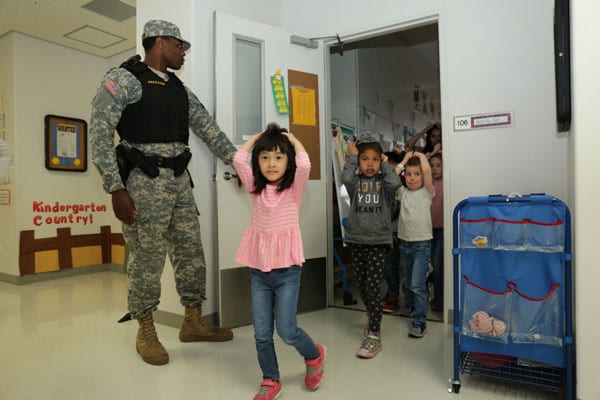
December 18, 2018; Boston Globe
Those who grew up in the 1950s during the Cold War, beside ordinary school fire drills, practiced what to do in case of an atomic bomb. It was never very comforting to crouch under one’s desk and hope it would provide protection from this nebulous threat, but children dutifully practiced and hoped the bombs would never materialize. For today’s schoolchildren, the threats and the drills are different. While fire drills remain familiar, “active shooter” drills have become part of almost every school’s safety practices. And now, as school shootings seem to be a reality that is not going away or being addressed in ways that will lessen the problem, a new way to prepare for the aftermath of a shooting is being offered and taught to students—trainings in how to treat gunshot wounds.
“Bleeding is the leading cause of death at a mass shooting,” an NBC News report about the trainings intoned last month, accompanied by images of Georgia high schoolers learning to bandage up their friends. “But one-third of victims can survive if treated within five minutes.”
As you gasp, you may think about the fact that these are children we are training to administer lifesaving techniques that paramedics and doctors’ study for years to do.
Sign up for our free newsletters
Subscribe to NPQ's newsletters to have our top stories delivered directly to your inbox.
By signing up, you agree to our privacy policy and terms of use, and to receive messages from NPQ and our partners.
Is this the right way to go? The government has been loath to take any position that would regulate guns in response to school shootings, looking for preventive answers in other areas. The announcement this week of a ban on bump stock devices that turn automatic weapons into machine guns was the first step in new gun regulations, but no others are in the works, and this one will have limited impact on the proliferation of guns and automatic weapons. So, the options for student safety remain a delicate balance of prevention and preparation.
The Department of Homeland Security awarded a $2.3 million grant to the National Center for Disaster Medicine and Public Health in November 2018 to deliver free, lifesaving, trauma training to high school students. The training will provide students with guidance in how to address traumatic injuries and control severe bleeding until first responders arrive. In other words, it confers the role of first responders on these students. But does such advance preparation increase or decrease the trauma?
Doctors, particularly those who work in trauma centers and emergency rooms, have been standing up for greater gun regulation and control as a means of prevention of gun violence, and yet, we are asking our children to be a stopgap in treating the aftermath this problem. Dr. Eric Goralnick, medical director of emergency preparedness at Brigham and Women’s Hospital, suggests we look at this from two perspectives: “One is prevention, which is the best. The other piece is once the injury happens, how do we reduce preventable death?” He also indicates that there are consequences to teaching students these things. Just by doing this, we could be creating more trauma for our young people as well as make them feel that the next shooting is just around the corner.
We have done little to resolve or reduce the numbers of school shootings or mass shootings in this country. The logical option of better regulating who has firearms has become so politicized that gun regulation did not even receive a mention in the School Safety Report issued this week by the US Department of Education as a follow up to the shooting at Marjory Stoneman Douglas High School in Parkland, Florida. But we do care enough about treating our children once they are wounded, to train their classmates in how best to do this. Somehow, that seems like putting a sparkly little band aid on a very big wound.—Carole Levine














